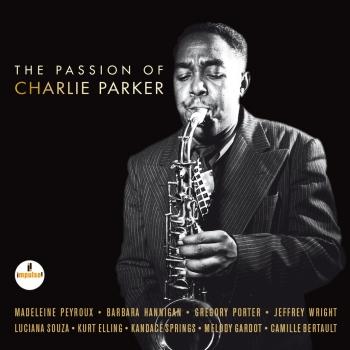
April In Paris: The Genius Of Charlie Parker #2 (Remastered) Charlie Parker
Album Info
Album Veröffentlichung:
1957
HRA-Veröffentlichung:
21.07.2016
Das Album enthält Albumcover
Entschuldigen Sie bitte!
Sehr geehrter HIGHRESAUDIO Besucher,
leider kann das Album zurzeit aufgrund von Länder- und Lizenzbeschränkungen nicht gekauft werden oder uns liegt der offizielle Veröffentlichungstermin für Ihr Land noch nicht vor. Wir aktualisieren unsere Veröffentlichungstermine ein- bis zweimal die Woche. Bitte schauen Sie ab und zu mal wieder rein.
Wir empfehlen Ihnen das Album auf Ihre Merkliste zu setzen.
Wir bedanken uns für Ihr Verständnis und Ihre Geduld.
Ihr, HIGHRESAUDIO
- 1April In Paris03:07
- 2Summertime02:47
- 3If I Should Lose You02:48
- 4I Didn't Know What Time It Was03:15
- 5Everything Happens To Me03:17
- 6Just Friends03:32
- 7They Can't Take That Away From Me03:18
- 8Out Of Nowhere03:06
- 9East Of The Sun (West Of The Moon)03:38
- 10Easy To Love (Album Version)03:29
- 11I'm In The Mood For Love (Take 3 / Alternate)03:34
- 12I'll Remember April03:01
Info zu April In Paris: The Genius Of Charlie Parker #2 (Remastered)
The genius of Bird and strings is hard to describe – an edgey approach that really goes far past most other 'jazz with strings' projects, not a ballad-driven one, but a tensely strained one that brings out some of Parker's best soloing, almost in a moody soundtrack-type way. The tracks are a lot freer and less bop-driven than some of Bird's normal work, and it's incredible to hear him soloing with such complexity – even more proof of the genius he clearly exhibited in relation to his contemporaries. Titles include 'Just Friends', 'Easy To Love', 'East Of The Sun', 'They Can't Take That Away From Me', 'April In Paris', and 'Summertime'.
Charlie Parker, alto saxophone
Stan Freeman, oboe, English horn
Mitch Miller, piano
Ray Brown, bass
Buddy Rich, drums
Recorded in New York on November 30, 1949
Digitally remastered
 Charlie Parker
Charlie Parker
The only child of Charles and Addie Parker, Charlie Parker was one of the most important and influential saxophonists and jazz players of the 1940’s.
When Parker was still a child, his family moved to Kansas City, Missouri, where jazz, blues and gospel music were flourishing. His first contact with music came from school, where he played baritone horn with the school’s band. When he was 15, he showed a great interest in music and a love for the alto saxophone. Soon, Parker was playing with local bands until 1935, when he left school to pursue a music career.
From 1935 to 1939, Parker worked in Kansas City with several local jazz and blues bands from which he developed his art. In 1939, Parker visited New York for the first time, and he stayed for nearly a year working as a professional musician and often participating in jam sessions. The New York atmosphere greatly influenced Parker's musical style.
In 1938, Parker joined the band of pianist Jay McShann, with whom he toured around Southwest Chicago and New York. A year later, Parker traveled to Chicago and was a regular performer at a club on 55th street. Parker soon moved to New York. He washed dishes at a local food place where he met guitarist Biddy Fleet, the man who taught him about instrumental harmony. Shortly afterwards, Parker returned to Kansas City to attend his father’s funeral. Once there, he joined Harlan Leonard’s Rockets and stayed for five months. In 1939, Yardbird rejoined McShann and was placed in charge of the reed section. Then, in 1940, Parker made his first recording with the McShann orchestra.
During the four years that Parker stayed with McShann's band, he got the opportunity to perform solo in several of their recordings, such as Hootie Blues, Sepian Bounce, and the 1941 hit Confessing the Blues. In 1942, while on tour with McShann, Parker performed in jam sessions at Monroe’s and Minton’s Playhouse in Harlem. There he caught the attention of up-and-coming jazz artists like Dizzy Gillespie and Thelonious Monk. Later that year, Parker broke with McShann and joined Earl Hines for eight months.
The year 1945 was extremely important for Parker. During that time he led his own group in New York and also worked with Gillespie in several ensembles. In December, Parker and Gillespie took their music to Hollywood on a six-week nightclub tour. Parker continued to perform in Los Angeles until June 1946, when he suffered a nervous breakdown and was confined at a state hospital. After his release in January 1947, Parker returned to New York and formed a quintet that performed some of his most famous tunes.
From 1947 to 1951, Parker worked in a number of nightclubs, radio studios, and other venues performing solo or with the accompaniment of other musicians. During this time, he visited Europe where he was cheered by devoted fans and did numerous recordings. March 5, 1955, was Parker’s last public engagement at Birdland, a nightclub in New York that was named in his honor. He died a week later in a friend’s apartment.
Charles 'Yardbird' Parker was an amazing saxophonist who gained wide recognition for his brilliant solos and innovative improvisations. He was, without a doubt, one of the most influential and talented musicians in jazz history.
Dieses Album enthält kein Booklet















